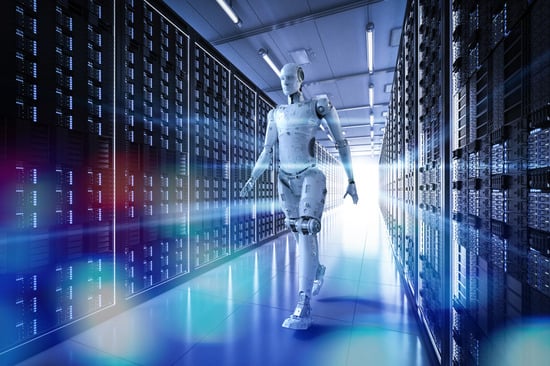The Future of Data Center Reliability: Trends and Innovations in Quality Assurance

Quality assurance has always played a critical role in ensuring data centers operate efficiently, reliably, and securely while safeguarding sensitive information and supporting seamless business operations.
As Rex Black, former president of the International Software Testing Qualifications Board, once quipped “Proper quality assurance (QA) of a data center is not a trivial matter.”
Those words ring even truer in today’s intelligent computing era with data center reliability relying on artificial intelligence (AI) driven quality assurance trends that are transforming data center QA with predictive maintenance and issue detection, repetitive task automation, improved decision making, enhanced security, and increased efficiency and cost savings, and more.
Data Center QA: It’s All About the Risks
Data Center QA boiled down to its basic purpose is to understand and mitigate all the risks in operating your data center from performance to security to functionality to usability to interoperability to other attributes important to your enterprise.
When all the risks are identified, it will not just be high-level concerns but specific risks that will need to be managed. Black estimated that a typical data center could have as many as 100 to 200 specific quality-related risks for AQ to tackle.
Quantifying the tangible returns on QA investment in data centers can be difficult as not only do you have to look at direct cost savings and efficiency improvements, but the limitation or prevention of downtime, data breaches, data corruption, and other negative events can have an incalculable price tag.
Some would argue that data center QA can return as much as $30 for every $1 invested. Regardless of the actual return, data center QA achieves:
- Minimizes Risks: By identifying and rectifying potential issues before they escalate, QA helps prevent disruptions and costly downtime.
- Optimizes Performance: QA ensures the infrastructure and equipment are installed and configured correctly, leading to optimal performance and resource utilization.
- Ensures Compliance: QA helps ensure the data center adheres to industry standards, regulatory requirements, and best practices.
- Builds Trust: Having a robust QA program builds trust with stakeholders by demonstrating a commitment to reliability and security.
We understand the importance of quality assurance and its impact on data center reliability at Data Center Systems (DCS) – all our cables are tested to meet or exceed the TIA 568-B industry-standard performance rating.
Of course, fiber connectivity solutions are just part of your organization’s data center QA which encompasses activities throughout the data center life cycle, from planning and construction to ongoing operation and maintenance.
The age of generative AI is truly changing the way we think about data center QA.
AI: Fundamentally Changing How Business Gets Done
Unless you have been underground at an Antarctica weather station without any internet connection, then you know the story of the past year was the role of generative AI and its impact on all aspects of our lives.
We expect that impact to accelerate in 2024 with PwC making some bold predictions on how AI will start to fundamentally change how business gets done including:
- The right AI choices will provide companies with a significant edge.
- Generative AI will be the “missing link” for data.
- Generative AI will give rise to new classes of products and services.
- Generative AI will transform transformation.
Data centers are on the front line of business process automation, data, and AI so expect to see AI-driven automation change data center QA by enhancing efficiency, streamlining processes, and reducing costs while reducing human error.
These AI-powered solutions will lead to the following quality assurance trends in the data center industry:
- Automating Repetitive Tasks: AI can automate routine testing and validation processes, including infrastructure, configuration, and performance checks. This frees up human expertise for more complex tasks and reduces the risk of errors due to manual fatigue.
- Predictive Maintenance and Issue Detection: Machine Learning algorithms can analyze historical data and sensor readings to predict potential equipment failures before they happen. This enables proactive maintenance, preventing downtime and minimizing repair costs.
- Improved Decision Making: AI can analyze complex data sets and identify patterns that humans might miss. This information can be used to optimize resource allocation, improve cooling efficiency, and make informed decisions about infrastructure upgrades. AI-powered dashboards can provide real-time insights into data center health and performance.
- Enhanced Security: AI can analyze network traffic and user behavior to identify potential security threats. This enables faster response to cyberattacks and prevents unauthorized access to sensitive data.
- Increased Efficiency and Cost Savings: By automating tasks and improving decision-making, AI-driven automation can significantly improve the efficiency of data center operations. This leads to reduced labor costs, lower energy consumption, and improved asset utilization.
- Scalability and Flexibility: AI-powered solutions can easily scale to accommodate growing data center needs. This makes them ideal for organizations with dynamic infrastructure requirements. AI can be customized to specific data center environments and workflows, ensuring a personalized and adaptable solution.
If AI only ends up doing a portion of the above, it will still be a “man on the moon” moment for data center QA!
Data Centers: Other Innovations in Quality Assurance
While AI will dominate the headlines in quality assurance trends in 2024, we expect these other data center innovations in QA:
Better Cooling Safety: Distributed Cooling Architecture
Compared to traditional centralized cooling systems, distributed cooling architecture offers several advantages when it comes to safety in data centers starting with the fact that a single device fault does not impact the operation of other devices since the subsystems are independent of each other.
This data center QA trend can lead to:
- Reduced risk of a single point of failure.
- Improved temperature control and hot spot mitigation.
- Faster fault detection and response.
- Enhanced scalability and flexibility
By providing targeted cooling where needed, distributed systems can improve energy efficiency compared to centralized systems that cool entire spaces. Smaller, modular units in distributed systems are also easier to maintain and replace compared to large, centralized units.
Full-Chain Safety: Product Design and Manufacturing
Reliable and secure data center operation is increasingly geared towards the concept of full-chain safety. This refers to the holistic approach to managing risks and ensuring the safety of all components, systems, and processes involved in data center operations. It goes beyond physical safety measures and encompasses:
- Product Design and Manufacturing: Incorporating safety considerations into every stage of a product's life cycle, from initial concept and design to material selection, manufacturing processes, and quality control. This ensures inherent safety features are built into the equipment itself, reducing the risk of failures.
- Deployment and Installation: Safe installation practices, qualified personnel, and adherence to best practices are crucial to prevent damage or improper configuration during deployment.
- Operation and Maintenance (O&M): Regular maintenance, predictive analytics, and timely intervention can identify and address potential issues before they escalate into failures. This includes software updates, hardware replacements, and adherence to proper safety procedures.
- Disaster Recovery and Business Continuity: Having robust plans and mechanisms in place to respond to emergencies, natural disasters, or security breaches helps minimize downtime and data loss.
Lifecycle Network Security Protection: Preventing Network Attacks
There really can’t be a discussion of data center QA trends without mentioning the uber-important topic of security.
As Data Center Knowledge reported last year, the data center industry continues to grapple with ever-evolving threats making security a top concern for organizations.
“By staying informed and proactive on the latest trends and best practices, data center professionals can ensure the safety and integrity of their critical assets,” said the publication.
One of the data center quality assurance trends is that lifecycle network security protection systems (encompassing supply security, in-depth defense, and O&M/operation security) will be called to shield facilities from attacks.
Lifecycle network security protection offers a layered defense, addressing vulnerabilities throughout the device's lifespan, including these key states and protection methods:
- Acquisition and Deployment:
- Vulnerability scanning: Identifying and patching known vulnerabilities in deployed devices before they are exposed to attackers.
- Secure configuration management: Ensuring devices are configured with strong security settings and access controls.
- Network segmentation: Isolating critical systems and data from less critical areas to limit potential attack spread.
- Vulnerability scanning: Identifying and patching known vulnerabilities in deployed devices before they are exposed to attackers.
- Operations and Maintenance:
- Continuous monitoring: Identifying suspicious activity and potential threats through real-time network traffic analysis.
- Intrusion detection and prevention systems (IDS/IPS): Detecting and blocking malicious network activity in real-time.
- Security information and event management (SIEM): Aggregating and analyzing security logs from various sources to identify broader attack patterns.
- Continuous monitoring: Identifying suspicious activity and potential threats through real-time network traffic analysis.
- Decommissioning:
- Data wiping: Securely erasing all sensitive data from devices before disposal or reuse to prevent unauthorized access.
- Device recycling or disposal: Following responsible practices for device disposal or recycling to prevent data leakage.
- Data wiping: Securely erasing all sensitive data from devices before disposal or reuse to prevent unauthorized access.
By actively embracing QA trends and innovations, data centers can ensure they are equipped to meet the ever-changing demands of the digital world. As a bonus, this should translate to improved efficiency, enhanced security, reduced costs, and a competitive edge in the industry.
Subscribe to News
LATEST NEWS
Thursday May 9, 2024
Friday February 9, 2024
Monday December 18, 2023







